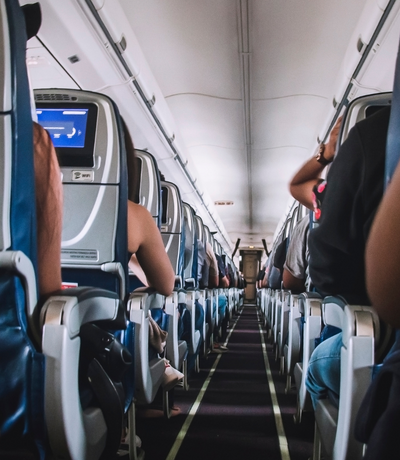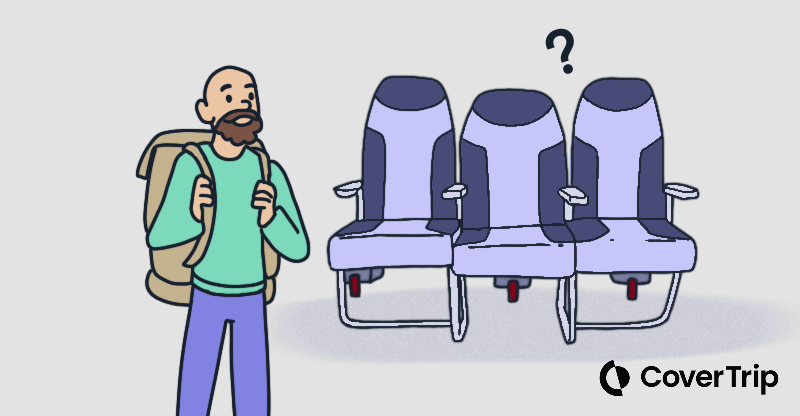How to Get the Best Seat for Any Trip
19 October 2024
There’s no shortage of complaints about airline seating these days. From seats with zero storage to those that don’t recline, savvy travelers have to do their research to avoid a bad seat.
Of course, it’s not a simple answer either because every trip is different depending on any number of factors:
- Flight length
- Travel partners
- Trip purpose
- Time of year
- and more
If you’re traveling with an elder parent or young child, you’ll likely make some different decisions than if you’re taking a short business trip with plans to return on the same day.
Here, I dig into how to choose the best economy-class seat for a variety of needs and offer tips on how to ensure that you’ll get the seat you want.

The best seat for a quiet ride
You can’t control all the noise around you, but some seats are generally quieter than others. If you’re sensitive to noise or prefer to sleep through the flight, getting a quiet seat could make the difference.
To keep the hustle and bustle of passengers and airline staff away from your ears, choose a seat some distance away from the serving galleries and lavatories. Seats closer to the front of the plane are slightly quieter than seats over the wing or near the engines. Finally, if you want to avoid the clink and chatter of the serving carts, pick a window seat and pop in your earbuds.
The best seat for a snooze
Some travelers can sleep easily on the plane, and others can’t. If you want to optimize your opportunity for an in-flight nap, a bulkhead seat (those right behind the separating walls between cabins) is ideal because you have slightly more room, and there’s no one in front of you to recline into your space.
Window seats are also great if you don’t need to get up to use the toilet, and you can lean against the wall. However, experts recommend putting something like a jacket or clean pillow between your face and the wall to avoid the potential for germs.
Pro tip: See Mastering the art and science of sleep when you travel.
The best seat for a tight connection
In the past, travelers were slightly more polite to each other and willing to wait in their seats to allow those with tight connections to get off more quickly.
These days, not so much.
If you know ahead of time that your connection time is limited, choose a seat as close to the front of the plane as possible and on the aisle to maximize your ability to deplane as quickly as possible.
Pro tip: Standing up and claiming aisle space immediately after the seatbelt light is turned off may help too.
See also: How to calculate the perfect layover time.
The best seat for maximum legroom
If you’re a little taller or have mobility issues, you know the value of extra legroom when you fly. The airlines measure legroom in terms of seat pitch, which is the distance between a point on one seat and the same point on the seat directly in front.
In the good old days (the 1960s), the average seat pitch of an airline seat was 35 inches. Some current low-budget airlines have reduced the seat pitch in economy class to as low as 28 inches!
If you want or need optimal legroom, you essentially have two options:
- Choose a bulkhead seat (those immediately behind the dividing wall or gallery), which typically has the most legroom, and accept that you will give up under-seat storage space.
- Choose an exit row seat, which has more room than the average seat, and accept that your seat will likely not recline.
Pro tip: Most airlines provide advance seat assignments for passengers with disabilities (according to the US DOT).
See also: My comparison of airline seat advisor websites.
Alternatively, you can get a row with an empty seat, which is our next tip.
The best way to get an empty seat next to you
Ever had that experience of the doors closing and there’s an empty seat or two in your row? It can feel like winning the lottery!
Having an empty seat in your row gives you the opportunity to take over your armrests, stretch out a bit without being rude, and it’s one less person to bother if you need to get up and move around the plane.
You can never guarantee an empty seat in your row, of course, but some choices you make will give you slightly better odds, and they are:
- Choose a seat near the back of the plane (a longer connection time helps with this).
- Traveling as a couple? Book the aisle and window seat in the same row. If someone does come to take the middle seat, it’s not hard to convince them to swap if you want to sit together.
- On a widebody aircraft, choose the center section because the side sections are more popular.
The last seats chosen are the middle seats and more expensive seats. If you can pay for an extra legroom seat, go for it. The expense just might mean you’re less likely to have seatmates.
See also: What every traveler should know about the middle seat.
The best seats for traveling as a family
Group and/or family travel in general adds an extra layer of complexity depending on everyone’s needs.
- If grandparents are coming along, they may need extra time boarding.
- If infants are coming, you can try requesting a bassinet seat, but these are usually in the bulkhead, so there may be high demand. Best to speak with the airline and make your request super early.
- If children are coming, you may have to spread out to cover an adequate adult-to-child ratio.
In some cases, families like to sit near the front to get off earlier (especially if the children have been cranky or vocal). In other cases, families may prefer to sit in the back as it’s closer to the lavatory, and there’s more chance of an open seat.
This one’s tough to call, so you’ll have to consider all the angles and start planning early.
See also: How to travel safely and solo with kids.
Related topics
Damian Tysdal is the founder of CoverTrip, and is a licensed agent for travel insurance (MA 1883287). He believes travel insurance should be easier to understand, and started the first travel insurance blog in 2006.
